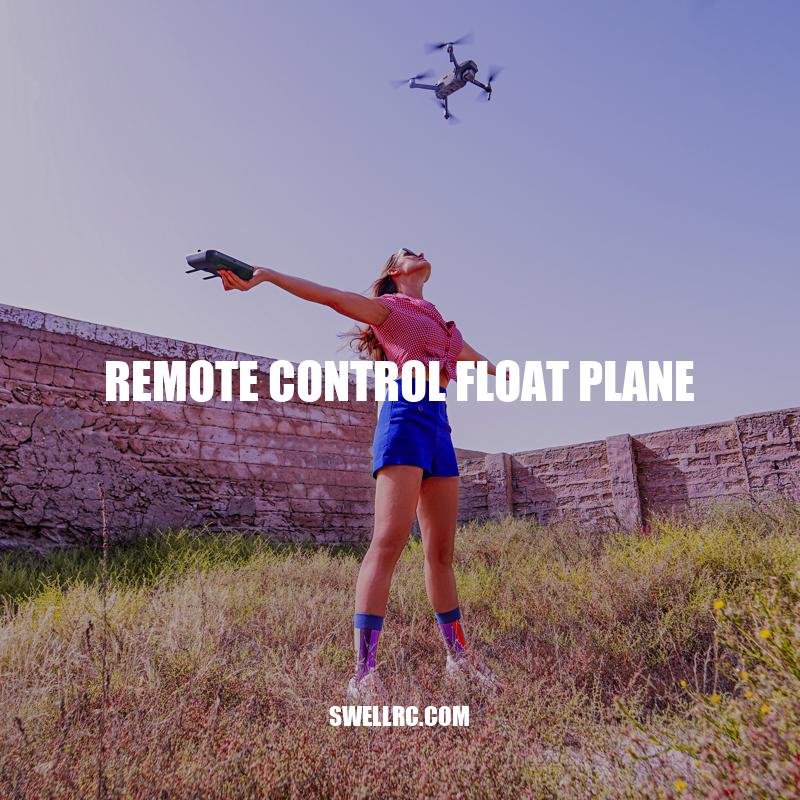Remote Control Float Plane: A Beginner’s Guide
A remote control float plane is a type of radio-controlled aircraft that is specifically designed to take off and land on water. It is a popular hobby among aviation enthusiasts who enjoy both building and flying these planes. Remote control float planes are made up of a variety of components such as the body, wing, propeller, motor, and a floating device known as a float. They are available in different types and models to suit the needs and preferences of different users. The demand for remote control float planes has increased over the years, with more people looking for ways to engage in fun and exciting outdoor activities.
What is a remote control float plane?
A remote control float plane is a type of radio-controlled aircraft that is designed to fly and land on water. It is made up of various components such as the body, wing, propeller, motor, and a float. The float enables the plane to float on water and helps the plane gain lift to take off and land smoothly.
There are various types and models of remote control float planes available in the market, such as electric, gas-powered, and nitro-powered planes. Remote control float planes come in different sizes and wingspans to cater to different user preferences.
Some popular brands that offer remote control float planes include Flyzone, HobbyZone, and E-flite.
What are the different types of remote control float planes available in the market?
There are various types of remote control float planes available in the market, including sport models, scale models, electric powered models, and gas-powered models.
How does a remote control float plane work?
- A remote control float plane works by utilizing radio-frequency signals to control its various components and movements.
- The controller sends signals to the receiver on the plane, which then translates them into movements of the motor, propeller, and other parts of the plane.
- The motor helps the plane gain speed and altitude, while the propeller creates thrust to move the plane forward.
- As the plane gets enough speed, the wings generate lift to help it take off and stay in the air.
- To land the plane, the pilot must slow down the motor and propeller and gradually lower the plane onto the water surface.
- Factors such as wind speed, water conditions, and plane weight can affect the performance and maneuverability of a remote control float plane.
Advantages of Remote Control Float Planes
- Ability to fly over water, providing unique scenic views
- Offers a more challenging flying experience compared to land-based planes
- Can be used as a means of relaxation and unwinding from daily stressors
- Facilitates opportunities to join and participate in flying clubs and events
Disadvantages of Remote Control Float Planes
- Cost of purchasing and maintaining a remote control float plane can be expensive
- Water currents, wind conditions, and other environmental factors can affect performance
- Requires a larger open water area to fly, compared to land-based planes
- Can be difficult for beginners to learn how to fly and maneuver the plane effectively
What are the advantages and disadvantages of using a remote control float plane?
Advantages of using a remote control float plane include the ability to fly over water and in inaccessible areas, ease of transportation and storage, and the ability to perform aerial surveillance and photography. Disadvantages include the risk of crashing into water, limited range and flight time, and the need for clear weather conditions and still water for takeoff and landing.
Benefits of owning a remote control float plane
- Owning a remote control float plane provides a unique and exciting recreational opportunity.
- It allows individuals to explore different waterways and landscapes from a bird’s eye view.
- Remote control float planes provide an excellent means of relaxation and stress relief.
- It can enhance personal development and promote a sense of achievement when mastering the art of piloting a remote control float plane.
- Remote control float planes can be used for competitions, events, and shows, allowing enthusiasts to network and share experiences with like-minded individuals.
- Many remote control float plane manufacturers offer a wide variety of products with different features, designs, and colors to cater to different needs and preferences.
What are the different types of remote control float planes available in the market?
The different types of remote control float planes available in the market are electric float planes, gas-powered float planes, and glider float planes.
Buying a remote control float plane
- Prioritize buying a remote control float plane from a reputable dealer or manufacturer.
- Determine the type of remote control float plane that fits your preferences and skill level, whether it’s a ready-to-fly (RTF) model or an ARF (Almost Ready to Fly) kit.
- Review the product specifications, including the size, weight, wingspan, and battery life, to ensure that it suits your needs.
- Compare the prices of different remote control float planes in the market and settle for a cost-effective option.
- Search online ratings, reviews, and forums for different remote control float plane models to gauge their performance, durability, and ease of use.
- Consider investing in additional accessories and spare parts for your remote control float plane, such as batteries, chargers, propellers, and motors, to ensure longevity and efficiency.
What are the important product specifications to review when buying a remote control float plane?
Important product specifications to review when buying a remote control float plane include the wingspan, weight, battery life, motor power, and control range.
Flying a remote control float plane
- Before flying a remote control float plane, ensure that you have charged the batteries and established a clear area free from obstructions and people.
- Assemble the remote control float plane according to the manufacturer’s instructions, checking that all components are properly connected and functioning correctly.
- Practice basic maneuvers and controls, such as takeoff, landing, turning, and pitch control, in a safe and controlled environment to familiarize yourself with the remote control float plane.
- Consider taking flying lessons from experienced remote control float plane enthusiasts or joining a flying club to enhance your skills and knowledge.
- Adhere to safety guidelines and regulations when operating a remote control float plane, such as avoiding flying near restricted airspace, low altitudes, and crowded areas.
- Record and analyze your remote control float plane flights to evaluate your progress and identify areas for improvement to enhance your skills.
What are some safety guidelines for flying a remote control float plane?
Some safety guidelines for flying a remote control float plane include selecting a safe and appropriate flying location, avoiding flying over people or property, checking weather conditions, performing pre-flight checks, and always keeping the plane within line of sight.
Conclusion
In conclusion, owning and flying a remote control float plane can be an exciting and rewarding experience. By providing an opportunity to indulge in a fascinating hobby and explore new environments, it can help one relax and develop one’s cognitive and manual dexterity skills. However, it is essential to follow the manufacturer’s instructions, adhere to safety guidelines and regulations, and continuously improve the remote control float plane flying skills. Additionally, one may need to invest in quality equipment and accessories, such as batteries, chargers, and propellers, for optimal performance. As a final point, remote control float plane enthusiasts can join online communities and forums to connect with other like-minded individuals for tips, advice, and product recommendations. Hence, remote control float planes offer a unique and thrilling alternative to traditional hobbies and can be a refreshing way to explore new environments and meet new people.



